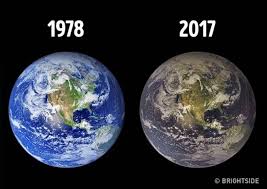13 facts with you about our world that we don’t have any explanation for.
Earth’s
magnetic poles can move and even change direction altogether, and
scientists have found that it’s happened many times. The latest switch
happened 10 million years ago and will probably occur again, but no one
knows why.
Fact: scientificamerican
11. We used to have two moons
Astronomers say Earth
had two satellites about 4.6 million years ago. The second one was
about 1,200 km across and went around the same orbit the Moon does,
until they collided. Such a cataclysm may explain why the two sides
of the Moon are so different.
Fact: Nature, space
10. Moonquakes
Few
people are aware that there earthquakes also occur on the Moon. Unlike
terrestrial ones, though, they’re not quite as powerful, and occur very
rarely. There’s a theory that they happen because of the tidal forces of the Sun and Earth, as well as falling meteorites.
Fact: nasa, nature
9. Earth spins really fast
Earth
is spinning at 1,600 km/h, and its movement around the Sun is even
faster at 108,000 km/h. We, though, can only feel the movement when its
speed changes. Because of the constant speed and the force of gravity,
we don’t feel it at all.
Fact: nasa
8. Time is "growing"
620M
years ago, a day on Earth lasted 21.9 hours. Earth is gradually slowing
down, but it happens at a rate of about 70 msec per 100 years,
so it would take 100M years for a day to last 24 hours.
Fact: nasa, spaceaim
7. Strange gravity
Our planet isn’t a perfect sphere, so there are high- and low-gravity areas on it. One such anomaly is Hudson Bay in Canada. Scientists found out that weak gravity there is due to the low density caused by rapidly melting glaciers.
Fact: science
6. The hottest and coldest points on Earth
The
hottest place on the planet is in Aziziya, Libya, where temperatures
of up to +58°С occur. The coldest place is the Antarctic, where it goes
down to −73°С. But the lowest observed temperature was registered at the
Russian Vostok Station on July 21, 1983 (-89.2°С).
Fact: gov, nworeport
5. The planet is severely polluted
This
is not really news. However, astronauts say that in 1978, the view
of Earth was rather different from what we see now. With lots of space
debris and waste, our blue, green and white planet is becoming brown,
gray and black.
Fact: chicagotribune
4. Earth consists of iron, oxygen, and silicon
If we separated
out the constituent elements of our planet, it would look like this:
32.1% iron, 30.1% oxygen, 15.1% silicon, and 13.9% magnesium. Most
of the iron (about 90%) is considered to be contained in the core, while
the crust contains the most oxygen (47%).
Fact: sciencing
3. The Earth used to be purple
Ancient
plants used retinal instead of chlorophyll to absorb light, which made
them reflect back red and blue, not green, giving purple as a result.
Incidentally, certain bacteria still use retinal.
Fact: livescience
2. A hidden ocean
Scientists
found a huge pool of water deep below Earth’s surface at 410-660 km.
It’s 2.7 billion years old, and has been found thanks to ringwoodite contained
in the mantle. The water is under immense pressure, and its volume
is enough to fill all the Earth’s oceans three times over. This has
given birth to a theory that the oceans appeared because
of an underground oceanic explosion.
Fact: theguardian
1. Life on Mars
After years
of speculation about lifeforms on other planets, scientists have found
some encouraging signs that a vital molecule required for this
is present on Mars, as seen in formations in the Gale crater. Also, some
large carbon-based molecules remain in the soil of Mars, and they
aren’t just the result of contamination from the rover itself. It would
suggest, that Mars had life on it long before Earth did.
Fact: americanscientist
courtesy: brightside
